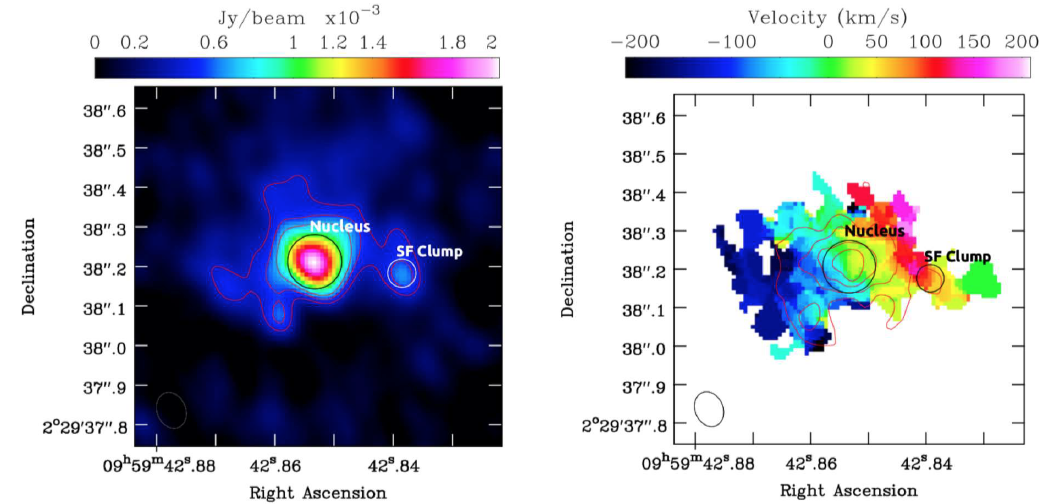Testing star formation laws on spatially resolved regions in a z ~ 4.3 starburst galaxy
Sharda, P., da Cunha, E., Federrath, C., Wisnioski, E., Di Teodoro, E. M., Tadaki, K., Yun, M. S., Aretxaga, I., Kawabe, R., 2019
Monthly Notices of the Royal Astronomical Society, Volume 487, 4305
[ ADS link ]
[ PDF ]
Abstract
We probe the star formation properties of the gas in AzTEC-1 in the COSMOS field, one of the best resolved and brightest starburst galaxies at z ~ 4.3, forming stars at a rate > 1000 solar masses per year. Using recent ALMA observations, we study star formation in the galaxy nucleus and an off-centre star-forming clump and measure a median star formation rate (SFR) surface density of Sigma_SFR (nucleus) = 270 +/- 54 and Sigma_SFR (SF-clump) = 170 +/- 38 M_sol/yr/kpc^2, respectively. Following the analysis by Sharda et al. (2018), we estimate the molecular gas mass, freefall time, and turbulent Mach number in these regions to predict Sigma_SFR from three star formation relations in the literature. The Kennicutt-Schmidt (Kennicutt 1998; KS) relation, which is based on the gas surface density, underestimates the Sigma_SFR in these regions by a factor 2-3. The Sigma_SFR we calculate from the single-freefall model of Krumholz et al. (2012; KDM) is consistent with the measured Sigma_SFR in the nucleus and the star-forming clump within the uncertainties. The turbulence-regulated star formation relation by Salim et al. (2015; SFK) agrees slightly better with the observations than the KDM relation. Our analysis reveals that an interplay between turbulence and gravity can help sustain high SFRs in high-redshift starbursts. It can also be extended to other high- and low-redshift galaxies thanks to the high-angular resolution and sensitivity of ALMA observations.
Figures
ALMA 860 micron continuum flux density and CO(4-3) velocity in AzTEC-1 (beam size as depicted in the lower left corners). The black and white circles in the two panels depict the nucleus and the star-forming (SF) clump we analyze in this work.

The following figure presents a comparison of star formation relations in multiple datasets, showing the measured and predicted SFRs, overlaid with the two regions (Nucleus and SF clump) of AzTEC-1 in brown.

Acknowledgements
We thank the anonymous referee for a constructive feedback which helped to improve the presentation. We thank Stephanie Monty and Harrison Abbot for useful discussions on flux densities. P.S. is supported by an Australian Government Research Training Program (RTP) Scholarship. E.dC. gratefully acknowledges the Australian Research Council for funding support as the recipient of a Future Fellowship (FT150100079). C.F. acknowledges funding provided by the Australian Research Council (Discovery Project DP170100603 and Future Fellowship FT180100495), and the Australia-Germany Joint Research Cooperation Scheme (UA-DAAD). E.W. acknowledges support by the Australian Research Council Centre of Excellence for All Sky Astrophysics in 3 Dimensions (ASTRO 3D), through project number CE170100013. E.M.D.T. acknowledges the support of the Australian Research Council through grant DP160100723. I.A. is supported through Consejo Nacional de Ciencia y Tecnologia, Mexico (CONACYT) grants FDC-2016-1848 and CB-2016-281948.
© C. Federrath 2025


